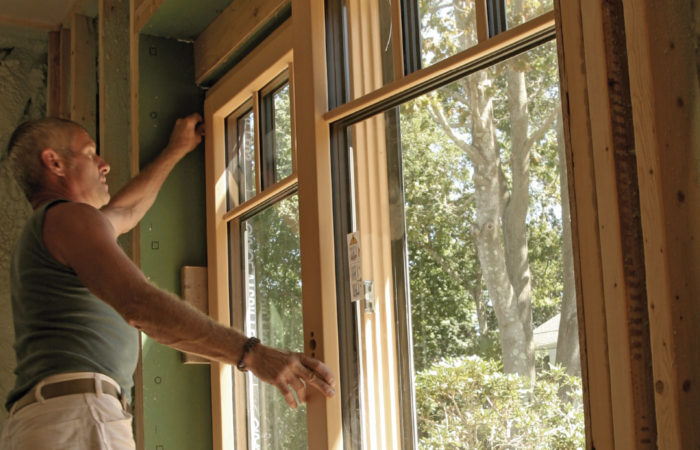
When you roll up to a house for the first time, you can’t help but notice the windows. Their size, style, and placement determine if they’re appropriate to the architectural style and, to some degree, if the house will be a pleasure to be in. For most people, that’s as much thought as they give to windows. And that’s too bad, because picking the right windows can lower heating and/or cooling costs, improve comfort inside the house, and improve indoor-air quality by dramatically limiting condensation. To buy the best-performing windows for your house, though, you need to know a bit about how they work and what they need to do.
A window has four basic jobs
The first thing a window has to do is control heat gain and loss. Technically, these temperature changes take place through conduction, convection, and radiation. As a practical matter, these temperature changes affect your comfort. If you’re sitting next to a window, you’ll experience conduction and convection when the glass acts as a cold radiator in the winter; and you’ll experience radiation on a sunny day when you feel like an ant trapped under a magnifying glass.
Second, a window must control solar-heat gain. I say control because heat gain isn’t always bad. If you live in a heating climate—generally speaking, anything north of Oklahoma with the exception of California—you should take advantage of the free heat windows can provide.
Third, windows need to regulate airflow. They should be airtight when closed and also offer fresh air when you want it.
Finally, windows provide natural light and frame views both near and far.
What makes a good frame?
When most people choose windows, they begin by considering the frame material. They might be predisposed to traditional wood or low-maintenance vinyl. However, according to Nils Petermann at the Efficient Windows Collaborative, the most important factor to consider is the frame’s durability. This is where I’d like to refer you to an independent organization that provides unbiased durability ratings for window frames. Unfortunately, there isn’t one.
You can make educated guesses about durability based on the frame material. But whether it’s wood, vinyl, fiberglass, aluminum, or clad, a well-constructed window lasts longer and performs better than a poorly constructed one regardless of the relative benefits of its frame material.
The best way to get a sense of window quality is to read all the product literature you can get your hands on and to look at actual windows—a lot of them. Go to the big-box store and the local building supply, and open and close the windows on display, paying attention to how the corners are joined, how well the sashes seal, and how rigid the unit is.
On vinyl windows, look for continuous thermally-welded corners. Examine the corner cutaway displays of aluminum windows for a continuous thermal break in both frame and sash. On a clad window, the cladding should have well-sealed corners and gaskets to prevent water from getting behind the cladding. Aluminum is an excellent heat conductor, so be sure that aluminum cladding doesn’t contact conditioned interior air at any point.
Another way to sift through the options is to talk to reputable builders and architects in your area. Ask what windows they use and how long they have been using them. They won’t stick with windows that make their clients unhappy.
When single-pane windows were the rule rather than the exception, companies looking to improve window performance focused their research on insulating glass. It was the lowest-hanging fruit. They’ve done such a good job that the R-value of insulated glass is good enough to make the window frame the weak link in the thermal chain. That’s one reason why manufacturers list performance data for relatively large windows, say, 4 ft. by 5 ft. (When you’re comparing windows, make sure the performance data are for windows of the same size.) Windows with large areas of glass yield better performance numbers because the frame is a smaller percentage of the window area. Savvy window designers understand this and tweak their windows accordingly for optimal performance. By using strong materials that permit low-profile sills, sashes, and jambs, they minimize the size of the conductive frame while being sure to incorporate materials that reduce air leakage.
Frame material can also influence how long a window stays airtight. Like most building materials, windows expand and contract with changes in temperature and humidity. When you see a window with moisture between panes, it’s likely that movement between the glass and the sash broke the insulating seal. By choosing stable materials, you can reduce stress on the seal and increase the window’s longevity. Fiberglass expands at the rate of glass, while aluminum and vinyl expand respectively 3 times and 7 times more than glass. Wood moves in response to humidity changes rather than temperature.
Insulated glass reduces heat loss
Manufacturers typically refer to glass as glazing. Using glazing as a noun is a bit pretentious, like referring to a window as a fenestration, but it does give the sense that glass assemblies in today’s windows are a far cry from the single-pane windows installed in the 1970s.
Those single-pane windows have been abandoned in most heating climates because glass is a horrible insulator. A standard window today relies on an insulated glass unit (sometimes called an IG). This unit is a sealed sandwich of two or three pieces of glass with an airspace between the panes. IG units are manufactured by a handful of glass companies that supply the hundreds of window manufacturers in North America.
The airspace between glass panes, usually 1⁄2 in. to 2⁄3 in. thick, serves as insulation by reducing the transfer of heat through conduction. A single clear pane has a U-factor of 1.04, but a sealed double-pane unit has a U-factor of 0.5. Adding a third pane improves the U-factor to 0.3.
Replacing the air with gas improves the insulating value of the window. Manufacturers use argon or krypton gases because they’re inert—chemically stable and nonreactive—and because they reduce heat loss, as they are less conductive than air. Argon and krypton also reduce convective losses because the gases are heavier than air, reducing gas movement within the insulating space.
Krypton performs slightly better than argon, but its bigger advantage is that the optimal spacing between krypton-filled panes is narrower than what’s required for argon. That means less stress on the sashes, particularly in triple-pane windows.
Window spacers impact performance
Spacers between glass panes perform three functions: They maintain a uniform separation between pieces of glass, they provide a good adhesive surface for the glass, and they create an airtight seal for the insulating cavity. Although you should choose windows based on their overall performance ratings, the spacer, while small, substantially impacts a window’s U-factor and condensation resistance.
The spacer’s job is complicated by the fact that it’s in contact with both the inside and outside surfaces of the window, forming a bridge between indoor and outdoor environments. Because the spacer is more conductive than the air or gas fill, it changes the temperature of a 21⁄2-in.-wide band around the edge of the glass. As a consequence, the window’s overall U-factor is affected. In smaller windows, the 21⁄2-in. temperature band is a larger percentage of the window and has a greater effect on the window’s U-factor. While spacers can be considered the Achilles’ heel of all windows, a casement window performs slightly better than a double-hung of the same size because the former has less spacer area. Likewise, the thermal performance of true divided-lite windows made up of multiple IG units suffers because of all the spacer area in the window. (Simulated divided lites can also affect U-factor if the grille creates a thermal bridge between the panes.)
Spacers are made of aluminum, steel, fiberglass, foam, and thermoplastics, often in some combination. Foam spacers have the lowest U-factor, while aluminum has the highest. Today, quality windows use “warm-edge” spacers. (It’s worth noting that warm-edge means only that it’s less conductive than aluminum.) A good warm-edge spacer raises the interior surface temperature of the glass along the perimeter of the window. This is especially important at the window’s bottom edge, which is most subject to condensation. At 0°F outside, a good spacer increases the temperature at the bottom of the inside glass pane by 6°F to 8°F. As a result, a more comfortable relative-humidity level indoors is possible during the winter without window condensation.
The benefit of window coatings and films
Energy-efficient windows were developed during the previous energy crisis. When Jimmy Carter was installing solar panels on the White House and making conservation a priority, the Department of Energy’s Lawrence Berkeley National Laboratory was charged with finding ways to conserve energy. Windows were among their targets. The insulating windows of that era allowed an inordinate amount of heat to escape. The lab’s scientists concluded that by using existing technologies to deposit a virtually invisible metal or metal-oxide coating on the glass, insulating windows could be dramatically more efficient. This coating is transparent to visible light, but blocks long- and short-wave radiation by reflecting it. Known as a low-e (for low-emissivity) coating, it’s common today even on low-cost windows.
Depending on the nature of this thin coating and which window surface it is applied to, the coating can reflect heat back into the room to conserve it or filter sunlight to keep heat out. Using a coating on two different glass panes can fine-tune the amount of heat that’s retained in each direction.
The measure of the amount of the sun’s heat a window lets through is the solar heat gain coefficient. SHGC in shorthand, it ranges from 0 to 1, where 1 is uninterrupted heat gain. A clear-glass, two-pane insulated window has an SHGC between 0.56 and 0.68, depending on the frame material and construction. The size of the air gap, which is influenced by frame design, and the amount of light blocked by the frame and grille affect the SHGC.
Another way to control the flow of heat through a window is with suspended films. These films come in two varieties: high solar gain and low solar gain. Because these films (similar to mylar) are so lightweight and thin, as many as three films can be suspended between two glass panes. The additional insulating spaces increase the insulating ability of the window, replicating the performance of three-, four, or five-pane windows without the weight. Serious Windows uses this approach to create high-performance windows with both high and low solar-gain properties. The company’s premium fixed window has an insulating value of R-11.1 (U-factor 0.09), nearly rivaling many wall insulations. The operable version of the window is R-7.1 (U-factor 0.14). Considering that the average insulating window is the equivalent of R-1 to R-3, Serious Windows live up to their name.
Daylighting strategies
Solar gain and insulating values aren’t the only ways that windows save energy and keep you comfortable. Windows also control the view and the amount of natural light. Daylighting, or window-placement strategies to maximize natural light, save money by reducing the need for electric lighting. Although placement is a design issue, window styles and glass properties affect the amount of light infiltration. The visible transmittance (VT) rating on the National Fenestration Rating Council’s (NFRC) label allows you to compare the amount of light that passes through windows, taking into account the light blocked by frames and grilles.
Impact-resistant glass offers protection
Although they don’t affect a window’s energy performance, a handful of options can make you safer. Tempered glass, for example, can be specified for windows located where someone could potentially fall into one. Many of these locations are covered by code and include windows within 18 in. of the floor, next to doors, in showers or bath areas, and along decks, patios, and walkways.
If you live in a coastal area particularly along the Atlantic and Gulf coasts, where building codes demand protection during hurricanes or in a tornado-prone area, you can specify impact-resistant glass. Using the same technology as car windshields, a plastic sheet is laminated between two pieces of glass so that the window maintains its integrity after the glass is broken.
Window frames can also be reinforced to withstand impact. Available in three different strengths (impact zones 2, 3, and 4), the toughest windows in impact zone 4 must withstand strikes from at least two 8-ft.-long 2x4s traveling at 50 ft. per second, followed by 9000 cycles of negative and positive pressure simulating hurricane force winds.
Noise-reducing acoustic windows and self-cleaning units
Manufacturers also offer variations of pebbled, frosted, and wavy glass that add privacy to bathrooms, bedrooms, and other sensitive spaces. If you live near a busy road, near train tracks, or under a flight path, acoustic windows can take the edge off loud or constant noise. Even if they don’t readily advertise the fact, many window companies sell sound-attenuating windows. Residential “quiet” windows are likely to be rated with a sound transmission coefficient (STC). A typical double-pane window has an STC of 25 to 27. Every increase of 10 in the STC cuts the amount of sound transmitted by half. Companies such as Milgard, Atrium, Marvin, and Serious Windows have windows in the 40 to 47 STC range.
For those of you who say, “I don’t do windows,” technology has finally caught up with your sentiment. Several big glass companies market coated glass that resists the buildup of dirt. Product names include Neat Glass by Cardinal, Activ by Pilkington, and PPG’s SunClear.
By making the glass smoother and hydrophilic, rainwater collects in sheets on the surface and slides off the glass quickly, cleaning the window. Some windows include a titanium-dioxide layer that reacts with UV-light to help organic materials decompose, so dirt washes away more easily.
Frame materials dictate performance, maintenance, and cost
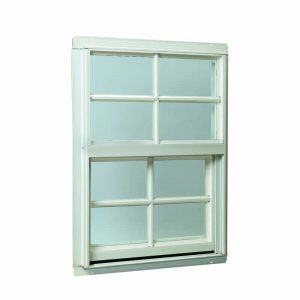
Aluminum
Aluminum frames are strong, durable, inexpensive, and require little maintenance. However, they are available in limited colors, and aluminum is highly conductive. To achieve even modest insulating levels, the frame and sashes must be carefully engineered with thermal breaks. Even then, they are best in mild desert climates or on impact-resistant windows in hurricane zones.
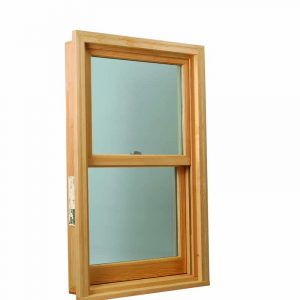
Wood
The only choice for some traditionalists, wood offers your pick of colors (and it can be changed later on). Wood frames are moderately priced and have good insulating value and structural strength, but they’re not low maintenance; they require periodic cleaning and painting, which adds to their overall cost.
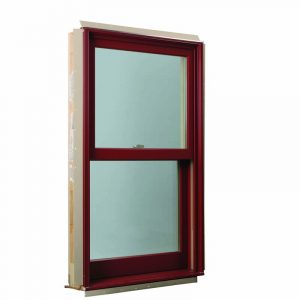
Clad
Windows with aluminum-, vinyl-, or fiberglass-clad wood frames are the most expensive. A clad unit offers the low-maintenance durability of aluminum, vinyl, or fiberglass on the outside, and the thermal resistance and appeal of wood on the inside. Well-engineered aluminum cladding should strengthen the window. Custom colors for aluminum cladding can match any paint chip at an additional cost.
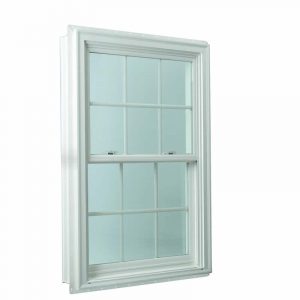
Vinyl
Vinyl frames are formed of extruded PVC. Multiple chambers in the frames and sashes add rigidity. These chambers also act as insulation in the same way as the airspace between glass panes; some manufacturers fill the chambers with foam insulation to improve the frame’s insulating ability. While it’s typically the least expensive window, vinyl is available in only a handful of colors, generally white and some variation on almond. Darker colors absorb too much heat, causing vinyl to deform and degrade.
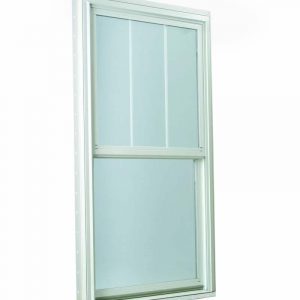
Fiberglass
The best you can get if you want to maximize a frame’s insulating ability, fiberglass is the least conductive material, and the frame can be insulated with foam. More expensive than aluminum, vinyl, or wood, fiberglass requires little maintenance and is durable and extremely strong. It can be extruded in low-profile frames and sashes in several colors and is paintable. Another advantage is that as the temperature changes, fiberglass expands and contracts at a rate almost identical to the glass. This helps to prevent seals along the glass from failing.
Windows need to insulate
Sealed airspaces improve insulation. The more insulating spaces in the glass unit, the better the performance; triple-glazed windows are among the most energy efficient you can buy. Aluminum, vinyl, and fiberglass frames use extruded chambers both for strength and as a thermal break. Filling these cavities with foam provides additional insulation. Solid-wood frames are about as efficient as vinyl.
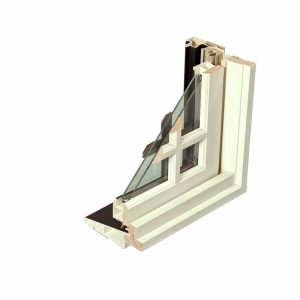
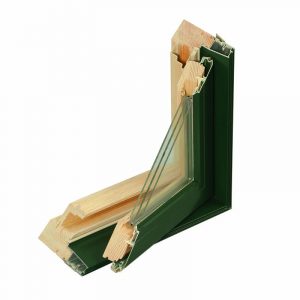
Reading a NFRC label
U-factor A measure of the insulating value. U-factor is the nonsolar heat flow through all parts of the window (glass, frame, and sash). A lower number means better insulation and greater performance.
Visible transmittance (VT) A measure of the amount of visible light that passes through the window. Values range from 0 to 1 (a higher number equals more light). However, most ratings are between 0.3 and 0.8 because they take into account the light blocked by the frame. Choose windows with higher VT to maximize daylight and views.
Condensation resistance A relative scale from 0 to 100 based on the window’s properties. It predicts the likelihood of condensation, with higher numbers indicating less condensation.
Solar heat gain coefficient (SHGC) The percentage of the sun’s solar heat that passes through the window. Higher numbers mean more passive solar-heating potential.
Air leakage (AL) A measure of the amount of air passing through the window assembly; a source of heat gain and loss. This optional rating is expressed in cubic feet per minute through a square foot of window. Look for ratings under 0.3; lower is better.
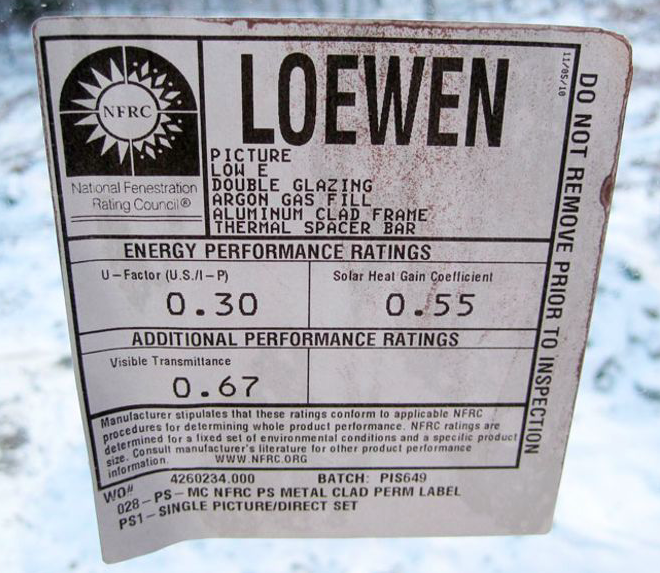
More about U-factor
U-factor rates a window’s insulating properties by measuring the flow of nonsolar heat through the window. You can think of it as the rate of conduction; the lower the U-factor, the less heat will flow through the window. (U-factor is the reciprocal of the more familiar R-value used to rate insulation. R-value measures resistance, so higher numbers are desirable.) Although we tend to think of a window as primarily glass, the frame makes up 20% to 30% of the unit.
U-factors are measured for the edge of the glass area, the center of the glass area, and the frame; but the important U-factor is for the entire window unit. Buying decisions should be based on this number, which appears on the NFRC label (above). U-factors for operable windows range from 0.14 for a super-insulating suspended-film unit to 0.5 or so for a basic double-pane window from a big-box store. Lower U-factors correlate with higher prices.
Window styles
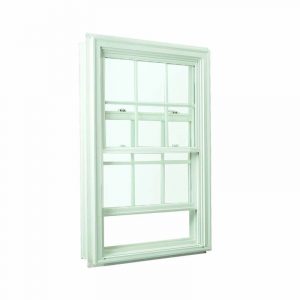
Double-hung: Traditional window composed of two sashes that slide vertically. A single-hung window looks identical, but the top sash is fixed.
Pros: Available with a wide variety of grille patterns to match different architectural styles. Sashes usually tilt in for easy cleaning of the exterior.
Cons: Sashes rely on draftier sliding-style weatherstripping. The bottom edge of the upper sash is exposed to outdoor temperatures on two faces, increasing surface area for thermal bridging. Two sashes increase spacer area, increasing U-factor. Less than half the window area can be open for ventilation.

Awning: Top-hinged window that usually opens outward with a crank.
Pros: Good-sealing compression-style weatherstripping. Single glass unit and recessed sash improve U-factor. Provides ventilation while it’s raining. Often used above and/or below large fixed windows for ventilation and additional daylight.
Cons: Screen on inside of window. Open window can present a hazard if installed along a walkway, deck, patio, or porch.
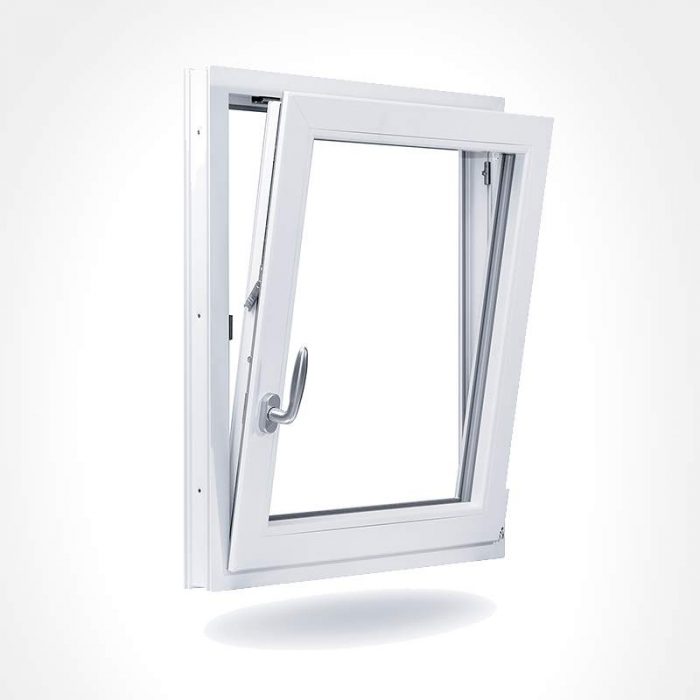
Tilt-and-turn: Dual-action window that can swing in like a door or tilt from the bottom like a hopper window for ventilation.
Pros: Ventilation options. Secure multipoint locking. Compression weatherstripping. Large egress area and easy cleaning.
Cons: Shades and drapes can interfere with operation.
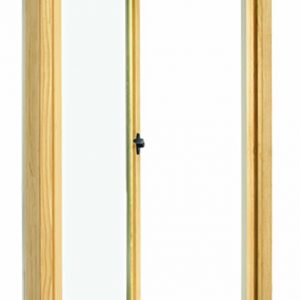
Casement: Side-hinged window that usually opens outward with a crank. In-swing versions are available.
Pros: Compression-style weatherstripping. Single large glass unit and recessed sash improve U-factor. Largest ventilation area of any window style. Opening can be oriented to “scoop” prevailing breeze.
Cons: Screen on inside of window. Hinge design might not allow outside of window to be cleaned from inside. Open window can present a hazard if installed along a walkway, deck, patio, or porch.
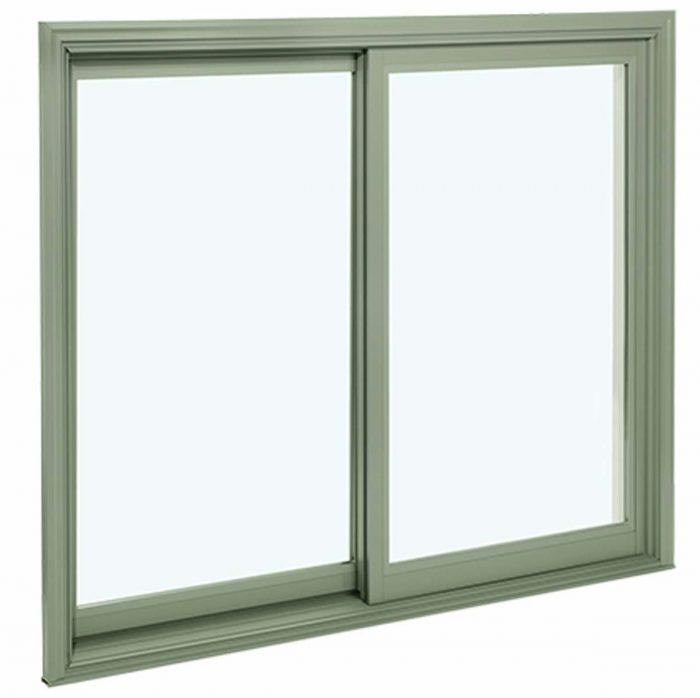
Horizontal slider The two sashes slide past one another on tracks like a sliding patio door.
Pros: Can be easier to open than other sliding styles, especially when placed over a counter.
Cons: Sliding weatherstripping and greater sash area lower U-factor and airtightness ratings.
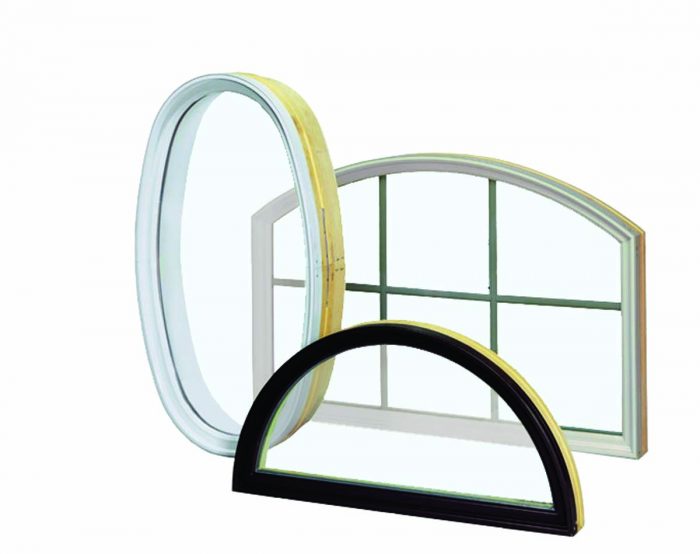
Fixed: An inoperative window available in shapes that match operable windows, or as accent windows such as half-rounds to create Palladian windows and octagons.
Pros: Improved airtightness. Can be made in nonstandard, custom shapes.
Cons: Doesn’t satisfy egress requirements.
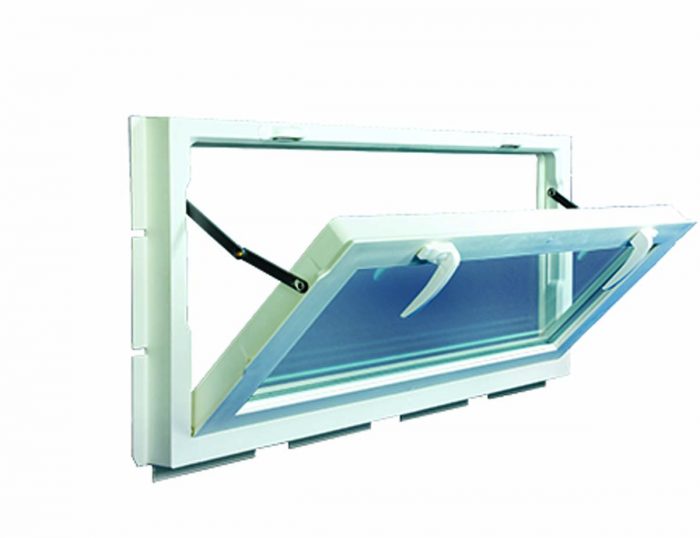
Hopper Tilt-in bottom-hinged window.
Pros: Compression-style weatherstripping. Single glass unit and recessed sash improve U-factor.
Cons: Hazardous if installed at head height or lower.
Replacement windows
You have three choices for replacing existing windows: a sash-only replacement; an insert-style frame and sash replacement window; or a new-construction window. If the existing frames have water damage, the only choice is a new construction window. If you’re looking to improve comfort or energy performance, replacing the sashes or using a frame insert can help. They’re a good choice on older homes where you want to preserve period trim, but from an energy and comfort standpoint, they’re not the best option.
Replacement windows that leave the existing frame in place don’t stop air leakage. If you’ve ever pulled out an old window, then you’ve seen fiberglass insulation stuffed between the window and the rough opening. Typically, the insulation is dirty. It wasn’t dirty when it was put there; dirt was filtered out of the air moving through and around the window frame.
Another negative is that insert-style frame and sash replacement windows reduce the glass area because the unit fits inside the existing frame. You might be willing to live with diminished views, but are you willing to pay for that privilege every year? In a southern climate, the reduced glass area does not affect heating bills, but in northern heating climates, reducing the south-facing glass area gives away a lot of free heat. An insert-style frame and sash replacement window is generally a bit pricier than a new-construction window. Installation costs are lower, however, because it leaves the existing trim in place and doesn’t require any siding removal.
Regardless of the type you choose, replacement windows are expensive. If you’re trying to save on energy expenses, new windows shouldn’t be considered until you have improved the insulation and the air tightness of the rest of the building envelope.
_________________________________________________________________________
Sean Groom is a contributing editor at Fine Homebuilding, where this article was originally published.
Weekly Newsletter
Get building science and energy efficiency advice, plus special offers, in your inbox.




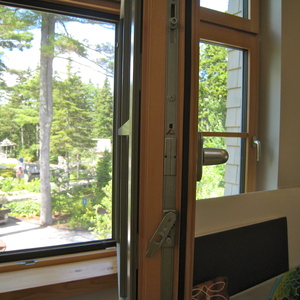
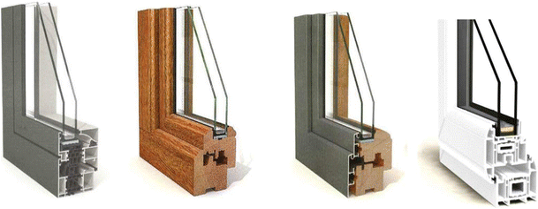
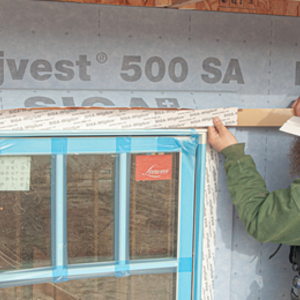







45 Comments
I'm a bit disappointed reading that black or dark uPVC may be an issue. I'm in Zone 4 and we have some really intense summers, is warping really a concern?
In a year or so I'll be ready to get my windows order together and was thinking of black uPVC European tilt and turns. Has anyone in a hotter climate had the uPVC warping issues hinted at in the article?
John,
It's only in the past few years that any of the vinyl window manufacturers have begun offering black finishes because of the risks. If your windows include a good warranty that might be enough reassurance, but you are definitely adding another potential p0int of failure that isn't present with lighter c0lours.
It's not the climate example your looking for but I put black vinyl Milgard windows in a new Oakland house in 2014. I had to go there last week and the windows are in really good shape including a couple of large South facing doors, one of which is very exposed to the elements.
The only NON-white uPVC window color I would trust is that made by German company REAHU.
"RENOLIT EXOFOL is the next-generation of high-performance foil for windows and doors. Applied to our window and door profiles after extrusion, these scratch-resistant and richly textured foil laminates come in a rainbow of solid and textured colors and natural woodgrain designs. But wait, there’s more good news.
After extensive testing against other color options like paint or lesser PVC foils, RENOLIT EXOFOL shows 150 percent improved weather resistance for longer color retention. The advanced pigment technology reflects away harmful UV rays and slows heat buildup, extending the life of our windows and doors. These laminates also resist moisture absorption better than PVC films by 45 percent.
Hence, RENOLIT EXOFOL acts like a coat of armor for our REHAU windows and doors, protecting against chalking, cracking and fading when compared to paint. So, no more scraping, priming or touchup: These windows will look like new again with just a little water, dish soap and a clean cloth. And we put our money where our mouth is with a 10-year warranty for BOTH exterior and interior applications of RENOLIT EXOFOL."
https://www.rehau.com/us-en/rehau-advantage-windows
Passivhaus projects in Europe often use "exterior insulation" to cover the edges of windows, in order to reduce heat loss further. Might be one way to use a black color on that "exterior insulation", and cover and protect at least the perimeter of a black window frame from the sun.
Thanks everyone, lots of things to consider here!
The article forgot to mention a frame material. German engineered, RAU-FIPRO. It's basically uPVC & Fiberglass hybrid frame mix.
"RAU-FIPRO is a co-extruded material made out of both uPVC and fiberglass. The combination creates a one-of-a-kind material with outstanding functionality and performance. RAU-FIPRO is at the core of REHAU’s GENEO® window system and can also be made into any custom window and door design by request. Windows made with RAU-FIPRO allow for an arched or half-rounded top. Any type of rounded window is not possible with fiberglass alone."
https://www.rehau.com/us-en/raufipro
Titanium Dioxide is the expensive ingredient in uPVC windows which keeps them UV stable and white. The more TD, the more stable and white the frames remain over the years. When you buy cheap economy vinyl windows, you can guarantee they they have the least amount of TD in them.
This is a good article that covers a lot of material, especially for beginners. It could have used some editing before republishing here. For example, I believe the Serious Windows company was bought out by Alpen about a decade ago.
Often there are Q&A postings from people who are seeking good window dealers or windows of certain types. Although GBA tries to avoid being advertising for some companies vs. others, a Buyer's Guide might list ways for consumers to find windows of the type desired, approximate prices, dealers with a good reputation, etc. Or point to those types of resources. Not an easy task to stay current.
Because fiberglass is stronger than wood, fiberglass frames can be a smaller area than wood, reducing the total amount of heat loss through the frame.
A common myth is that low-E coatings should be deployed differently for keeping the heat in or keeping the heat out. But fortunately, any set of coatings that is good for one is good for the other. The U-factor is the same for either direction of heat flow.
I mention that partly because the article says that the coating deployment can "fine-tune the amount of heat that’s retained in each direction." That might be read as indicating that you can adjust the coatings to get different thermal resistance for the different directions of heat flow. You can't.
The difference between cold-climate and hot-climate windows is only in the tuning of the SHGC, not in the direction that they block heat flow.
Question: is the window in the first photo from Loewen? Looks very nice and looks a lot like my Loewen windows.
It may be a very small difference, but there is a difference there. Let's use a double glazed window as an example. In the summer, putting the LowE on #2 helps keep solar heat from warming the fill gas, which can help keep the interior a bit cooler. Conversely, putting the LowE on #3 helps keep the indoor heat from warming the fill gas, which helps keep the interior a bit warmer.
But in the end, yes, it's a rather minute difference in U-factor.
The article also mentions putting two LowE coatings on two different surfaces. For double glazed windows, it would usually be on #2 and #4. Putting two of the same LowE coatings on two different glass surfaces (such as Solarban 60 on #2 & #4) is no more advantageous than a single LowE coating. But putting two different LowE coatings can help. For the company I worked at, we commonly used SB60/70 on #2 and Comfort Select 73 on #4. This helped lower the window U-value by a few points, which helped when a client needed a window to meet a maximum energy code U-value.
Of course, there is always a tradeoff. The LowE coatings tend to darken the glass and reduce Visible Transmittance (VT). They don't darken as much a tints, of course, but they definitely reduce the amount of visible light coming in.
What you describe is a difference in the SHGC, not a difference in the U-factor. The position(s) of the coating(s) can have a major impact on the SHGC. There are even windows that you can flip around, facing a different surface outside or inside for summer vs. winter to get a different SHGC!
But the position of the coatings can't be gamed to trade of winter vs. summer U-factor. What's best for one is best for the other.
Sorry for late reply. I get no notifications of replies through my email.
Yes, Low-E coatings affect SHGC, but they also affect U-factor. If they didn't affect U-factor, then manufacturers wouldn't bother to use them as extensively as they do now. SHGC is mainly a hot climate issue, whereas manufacturers use Low-E coatings in all climates. Based on NFRC calculations, the effect is pretty dramatic vs clear glass, with a difference of around .10 at U-factor of .50. See for yourself:
https://search.nfrc.org/search/searchDefault.aspx
But your 2nd point is correct. There isn't that much difference between summer and winter U-factor. Winter U-factors are usually worse, but only by a .01 or so.
Good article. Some day perhaps I can afford full-frame replacements.
We have almost finished our double-stud superinsulated house here in Lancaster County, PA. While we were investigating windows it was difficult to find numbers for air leakage. The literature of one company, ProVia out of Ohio, impressed us as one that was focused on energy efficiency and gave numbers for air leakage. We ended up using their vinyl casement windows, triple glazed, krypton filled for a U-value of around 0.16. Our building inspector commented that he had never seen such efficient windows. Our local supplier would not sell direct to me because they only did wholesale, but our Amish framing help gladly worked as the middleman between me and the company without any price markup. The price for these very efficient American-made windows was in the same ballpark as the quote I got from our main lumberyard for ordinary double-pane argon windows. ProVia also sells doors and IIRC claims that their one model is the most efficient door in the US being something like 3" thick. We are happy customers.
Lack of regularly-reported air leakage on windows and doors is a MAJOR point of irritation to me.
Perhaps I'm just a cynic, but I think this is intentional. Window companies want to market and charge more and more for increasingly marginal U-factor improvements in the glazing (sorry, Sean) while ignoring the fact that the amount of outside air that's leaking in through their cruddy double-hung seals is swamping any teeny gains in insulation value.
Donald,
When I was working at a window manufacturer (I left the company about 4 months ago), we had to do air-leakage testing of our products to get the AAMA/CSA Air-Water-Structural (AWS) certification every 10 years. For any products that you're particularly interested in, just ask the manufacturer's rep for their AAMA/CSA AWS report for that product to get air-leakage numbers. It's basically run at the same pressures as the energy code requirements (IECC), and the IECC actually cites the AAMA/CSA test numbers.
Great article!
I wish someone would do a similar article covering only glass coatings and the different options with regard to which surfaces different coatings can be applied to and what the benefits/drawbacks are to different approaches.
For example, I'm most interested in Condensation Resistance. My ultimate goal is to keep 40% RH @ 23 C indoors on the cold edge of CZ6A. I would not choose to sacrifice CR to get a slightly better U value. CR is a spec I rarely see on windows, and some companies do not provide it even when asked.
I've read that placing a LoE coating on the interior side of the interior pane can benefit U value but also hurts CR.
Your best bet is to go to one of the three big IGU/glass manufacturers' websites (e.g. Cardinal) and look at their performance charts for all of the different coating combinations they offer. That will tell you what you need to know.
Most window manufacturers choose from these combinations and buy as fully assembled IGU's (except when the Architect has a Quentin Tarentino moment and calls for some oddball glazing combination as a special order). And if any window manufacturer is assembling their own IGU's, personally that's a red flag for me. There's no way they can compete with the massive testing and QC procedures that the glass manufacturers put their assembled IGU's through.
As far as condensation resistance, for 40% RH and 23 C (73 F) indoor temperature, the dew point temperature is 9 C (48 F). So you need a window where the temperature of the interior pane of glass remains above 9 C (48 F) under the climate conditions you require (in your case "the cold side" of CZ6A). Technically, that's not the whole story, but that's the best we're going to do without a full analysis of the convective currents between the panes of glass near the edge, the physical placement of their spacers, etc.
And never mind the stupid CR index or CRF factor. They tell you nothing of any significance.
Ask the window manufacturer for their test results showing the temperature of the interior pane of glass for the window under the climate conditions you're interested in. The trouble is that most of the manufacturers won't have the data you need. In fact, most won't even understand what you're asking them.
So the practical recommendation is that you will need good quality, triple pane windows (U 0.2 or better, and good air infiltration specs.) to be reasonably confident that you can avoid all condensation in CZ6A if you set your indoor temperature to 23 C (73 F) and expect a maximum 40% RH. If you want to be even "more confident", buy better windows with even lower U values.
I worked at a window manufacturer until 4 months ago. I didn't know all the ins and outs of the manufacturing process, but I am reasonably certain that we made most of our own IGUs. Based on my experience with trying to pass a FenStar Verification Test (a quality control check by the NFRC for Energy Star products), I would say we didn't have a good grip on IGU quality.
For your point on condensation numbers, I would ask specifically for edge-of-glass (EOG) temperatures first, since those are closest to the worst thermal performance parts of the window (the spacers, sash frame). If those temperatures are ok, then the center-of-glass (COG) numbers should also be ok.
Good point about the edge-of-glass temperature specifically. Thanks.
No problem. Thanks for your post above, it was very informative!
Lance,
CR can be found easily for all products listed in the NFRC CPD (Certified Product Directory). The CPD numbers (U-factor, SHGC, VT) are the same ones listed on the window label. You can find the CR for the product line you're looking at, and the exact glazing setup:
https://search.nfrc.org/search/cpd/cpd_search_default_ByMfr.aspx?SearchOption=M
CR (condensation resistance) is measured through THERM and WINDOW, which are both heat transfer modeling programs. Therefore, CR are numbers determined through computer simulations.
The CRF (condensation resistance factor) is determined through actual physical testing. CRF is based off an AAMA test standard (AAMA 1503), and is mainly used to test the condensation resistance of the window frame components. It also measures the condensation resistance of the glass, but that's not the main focus of the test:
https://www.intertek.com/building/standards/aama-1503/
The window manufacture that I worked at made aluminum and vinyl frame windows. We only ran physical CRF tests (AAMA 1503) for our aluminum frame windows because vinyl windows wouldn't have any potential condensation problems. Also, we only ran these tests when we were re-certifying our products on the NFRC CPD (because we were going to have the products physically tested anyway, and it was cheaper to run the AAMA 1503 test while the product was in the test apparatus already). As of the time that I have left the company, we planned run the CRF test on a vinyl product just to see what numbers we got.
There is a relatively new technology not mentioned in the article, known as "thin-triple" glazing. the center glazing is made out of a a very thin glass developed by the Corning Company. It is very strong, though thin, and can be used in large sheets. The advantage is that the insulated glass unit can be kept thin and light enough to be installed in typical double glazed window sash, which keeps cost down for the window makers. Several window makers are already using it.
Interesting. Any idea on what companies are using it?
Anderson and Alpen High Performance Products are two firms I know of.
Thanks
For both the "thin-triple" and "suspended film" windows, the reason manufacturers are developing these products is partly due to cost. I worked at a window manufacturer until 4 months ago, and my boss claimed triple glazed IGUs cost the company twice as much as double glazed IGUs. Of course, this was probably due to the fact that the vast majority of our products were double glazed, thus, our tooling was setup to make double glazed IGUs.
But for manufacturers, the main advantage of "thin triple" and "suspended film" windows is weight savings. This is especially true for Passive House designs, which encourage using fewer individual windows, so designers often include larger individual windows in their designs. As a result, large triple glazed sashes/vents (with full thickness center glazing) put enormous weight and stress on the hardware, which necessitates thicker hardware and more reinforcement points. This in turn creates more thermal bridge areas in the window frame.
DC: The DOE webinar I watched said that the Thin Triples IGUs could fit in existing frame designs, so they would cost the window makers much less to furnish than a normal heavy triple glazed IGU. Of course there is probably a premium the window maker has to pay the IGU maker for this product, which I guess is a specialty item at this time. But if demand and production ramps up, it could become standard.
Gene,
Thanks for the comment. The limiting factor is the gas-fill cavity, which should be ideally around 1/2"-5/8" for each cavity when filled with argon gas. TG IGUs with thinner cavities might have worse performance than DG IGUs with 5/8" thickness. The cavity can be narrower for krypton gas, but krypton is also much more expensive.
https://www.bregroup.com/insights/is-bigger-always-better-triple-better-than-double/
So in terms for IGU replacements for windows designed for DG IGUs (my old company's products were typically 7/8"-1.25" IGUs for the older products), thin triples or even suspended film IGUs may not work well. Their gas cavities would be too narrow to be thermally effective, and might even be worse than the DG they are replacing. You'd need the window IGU thickness to be at least 1.5" for an effective IGU retrofit.
So existing windows should mostly stick with DG IGUs for now. But when considering new windows, opt for IGUs of 1.5" or greater thickness to take advantage of triple glazing with ideal gas cavity spacing (whether as regular triple, thin triple, or suspended film). Also, don't forget that the glass thickness for the outside panes must become thicker as the window becomes larger to handle the increased structural stresses.
A few cons to different window styles that I've learned from having sliders, casements, and double hungs in my house.
Casements are a pain to manage if you don't have air conditioning and open windows at night. If it rains, you have to wake up and close them all. If you are too late, sash gets wet and the bug screen prevents you from easily wiping them down, so the water will drain into the window frame. With , say, a Andersen 400, now the water drains into the wood frame behind the vinyl cladding. If I get caught with wet sashes typically leave them just cracked so they can drain to the exterior.
Horizontal sliders collect alot dirt in the tracks. Some slider designs collect water into the groove/frame that holds the screen, and though there are drains for this area, often the water also drains under the sash into the window track - resulting in a puddle on the interior side. This water plus the dirt in the track can really make a grimy situation. Some sliders have better designs that eliminate this flaw.
The only windows that work well with window ACs are double hungs. I wish I had a double hung in my bedroom so I could use AC to sleep in the worst of summer!
Fixed windows can be tough to replace broken glass if there isn't an removeable sash. You can't just pull the sash out drop it off at the glass shop. Perhaps best to always use window trim with fixed windows so the nailing fin is not buried under the siding. Same goes for any window with fixed glass, such as budget sliders with one moving sash.
Single hung (just bottom sash is moveable, fixed top sash) leak less air than double hung windows (their weakness), and also will accommodate window AC units. Single hung are a bit tougher to clean, maybe a bit cheaper price, maybe not available from some manufacturers.
At the window manufacturer that I used to work for, we only have one single hung product. It was a vinyl frame window, and it was targeted only towards the house-flipper and speculator market. It barely came with any options other besides installation options.
All IGUs can be removed from any window for glass repair/replacement, even for fixed windows. There is usually a set of glazing beads that hold the window in around the perimeter. You would often use a flathead screwdriver to gently pop them all off to remove the IGU for broken glass replacement.
DC_Chan, I don't know what windows you use, but I just double-checked section details for the ones I often use: wood-framed, aluminum-clad Loewen and Sierra Pacific, and fiberglass-clad Marvin Elevate, and none appear to have a removeable bead. Maybe you can pop the exterior cladding off but I would be nervous to try that.
Hi Michael,
Thanks for your comment. Perhaps I was wrong to say "all", and should have said "many". With that said, it seems rather dumb that a modern window design wouldn't have a glazing bead, since it makes the replacement of IGU much easier (which may be necessary if you keep your window frame for a while, since the argon/krypton gas will eventually escape after many years).
Simonton has a wooden fixed window, and they show you how to replace the glazing bead.
https://www.youtube.com/watch?v=L1sUMCp3Wq4
Loewen - for fixed window, the glazing bead appears to be on the outside. Not the easiest replacement, but possible without removing the entire window frame:
https://www.loewen.com/wp-content/uploads/2018/05/Loewen-TechnicalGuide-D-web-1-1.pdf
Sierra Pacific - the Aspen line has glazing beads. Here's the parts catalog for the casement window:
https://www.sierrapacificwindows.com/TechnicalDocuments/Window/Casement/Aluminum%20Clad%20Wood/Aspen%20Casement/Replacement%20Parts%20Catalog/Aspen%202%20casement%20parts%20catalog%205-27-21.pdf
Marvin - wood interior seems like it can be removed from the fiberglass exterior, but I'm not 100% sure. Marvin does not refer to any glazing beads:
https://www3.marvin.com/WebDoc/Parts_Elevate_Double_Hung.pdf
DC Chan, the day you posted, my Sierra Pacific rep came out to help me install windows for a day. We talked about the glazing bead issue and he said some lines have it, some lines don't. He said that as much as he's not a fan of our throwaway culture, the fact is that if the glass breaks, it's usually simpler and better to just get a whole new sash. By the time you remove the glazing bead, remove the existing glazing, set new glazing, re-attach the glazing bead, refinish as necessary and re-install the sash, the labor would pay for a whole new sash in most cases.
Have you used Matthews Brothers windows? I am considering their triple pane DH & Casements but am concerned with their low SHG (.22) and VLT (.35) numbers. Going to investigate Provia. New construction windows in a CT house. Will use Zip R9 and 5.5" mineral wool so need a decent (make & price) window to complement the air tight, well insulated construction. Open to tilt turns as well. Alpen Tyrol=50k, Matthews triple pane= 27k. Suggestions welcome.
Yes, or at least I spec'd Mathews Bros Sandford Hills casement-style windows on a recent project. Their price and performance values were excellent. I need to catch up with the builder and owner to hear what they think of the quality.
That is what I am considering (triple pane). If you could get some feedback on whether they think the lower VLT is noticeable, I would sure appreciate it.
Thanks
A
I have experience with matthews bros window inztalkations on 5 homes in a net zero development.. both .good and bad window results. As with many vinyl frame windows the frames are like noodles and need to be painstaikenly installed without a hint of a bow (crown) in the sides or else the double hung weatherstrips leak air badly. By the time the builder got to the 3rd house he started to order the windows with built in wide flat casing which made them quite rigid (allowing weatherstrip to work properly) We had same problem with the few casements he used as well.
User 706etc,
I have Alpen triple glazed units with the low SHGC of .24 and a VT of .43 as best I can tell. I have seen notes on specification sheets that the VT might be derived from the window sash size not the glass area, so the actual visual transmission of the glass may be higher than you think. Heavy frames will consume more area relative to the glass and distort the VT downward. Check narrow frame fixed VT versus operable Euro styles in the same glazing to see.
The actual effect of the lower VT will likely be less than you think. I have found that the "darkness" of a low SHGC glazing is only noticed when a casement window is open enough to compare the outside brightness relative to the window sight line. Sliding doors that are open for summer breezes might be the most revealing situation due to a doubling effect of the VT where the doors overlap. As a practical matter, I have found the low SHGC/VT to be advantageous in my high altitude setting. Particularly during winter when the snow can be quite blinding.
My own highly insulated home was designed to minimize solar gain on all sides, as the potential winter heat gain would not be worth the summer heat gain, even the shoulder seasons here are very sunny. I do not have AC thanks to our semi arid conditions and 30 plus degree evening temperature swings. I can make use of the thermal buffering provided by internal mass to make it through the following day.
You may find the energy analysis for your area will show that low SHGC on the three sunny sides will lower required AC capacity and energy expenditures in a favorable way. Trying to gain winter heat with higher SHGC glass is seldom a good trade. I do believe Connecticut is cloudier overall.
The only real-life effect I can relate to you is that going out onto my deck in the evening will sometimes surprise me at how the sunset isn't quite as far along as I thought when inside the house. Sort of like taking off a pair of not very dark sunglasses at twilight. The effect is much more noticeable then, not during the middle of the day.
Regarding filling the space in double or triple pane windows with a gas, it appears that the most common gas is argon. We got triple glazed windows from ProVia and while they do use argon, we chose the krypton option which provides an even lower U-value. I'm not sure about the tradeoff in price vs increased efficiency and comfort. But I do recall from Chemistry how the temperature of a gas is simply a measure of the average kinetic energy of the gas particles. Since the equation for kinetic energy is 1/2mv^2 and since krypton atoms are much heavier than argon atoms, their speed is much slower so that compared to argon they do not quickly transfer heat by moving around from one pane to the other.
Hi,
we supply high performance European Windows & Doors.
We are located in NYC but we do supply all over the USA, We have NFRC & Passive certified Windows & Doors made of Upvc, Aluminum, Alu-Clad & Wood.
Don't hesitate to contact us if you are looking to get a quote for European tilt & turn Windows.
Visit our site for more information:
https://www.albaeuropeanwindows.com/
[email protected]
(718) 678-7401
Who do you recommend for windows and doors in the Colorado area?
mikesee,
You might want to check out Alpen windows at ThinkAlpen. They have moved to a new factory near Denver and if you are building at higher elevations, their windows can be shipped with the argon intact thanks to the bladders they attach to the windows. The gas bladders allow equalization of the internal stresses placed on windows being shipped over 5,000 ft.
Seven years ago when I was shopping windows I found that several major brands would only ship with air fill. One brand even had an argon cut off 4,500 ft which kinda nixed all of the Denver market. Maybe these days more brands will ship with argon or krypton, but be sure to get written verification. Your U values will take a hit if only air is the fill gas.
Alpen also reps the ProVia door line about which you may have seen in comments earlier in this thread. I would post the name of the rep I used, but I am not sure of the rules.
Log in or create an account to post a comment.
Sign up Log in